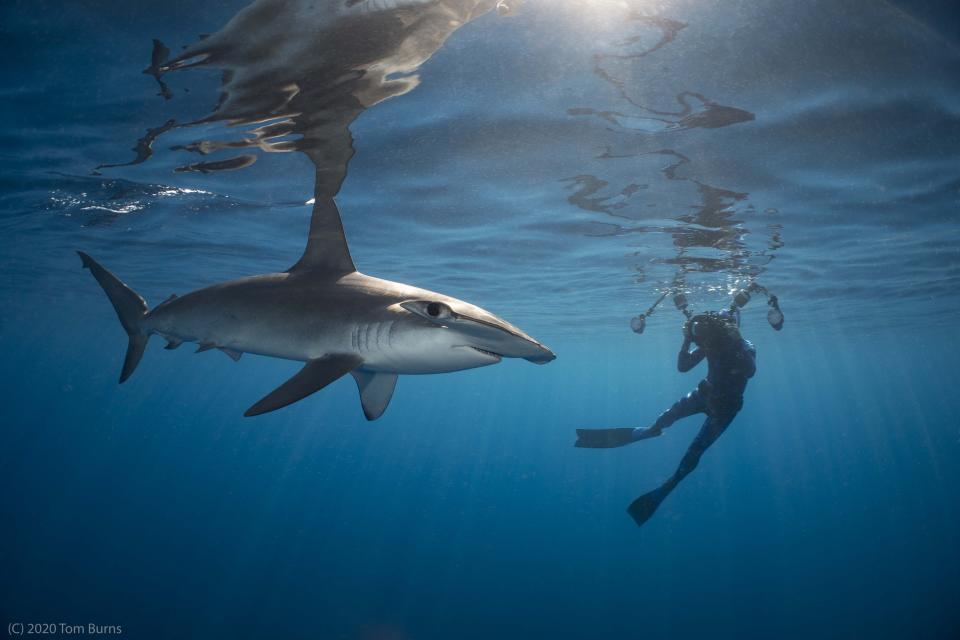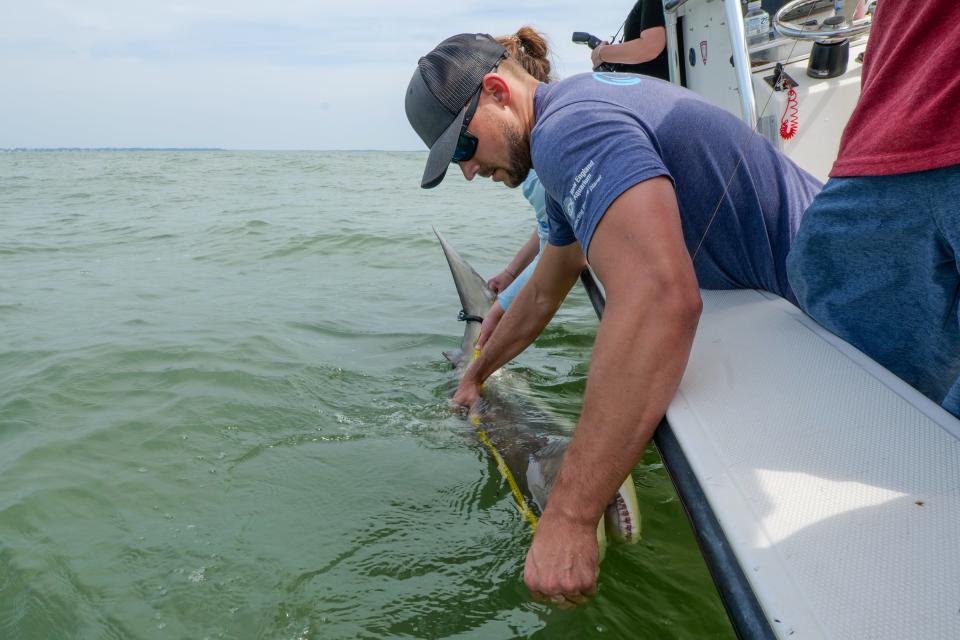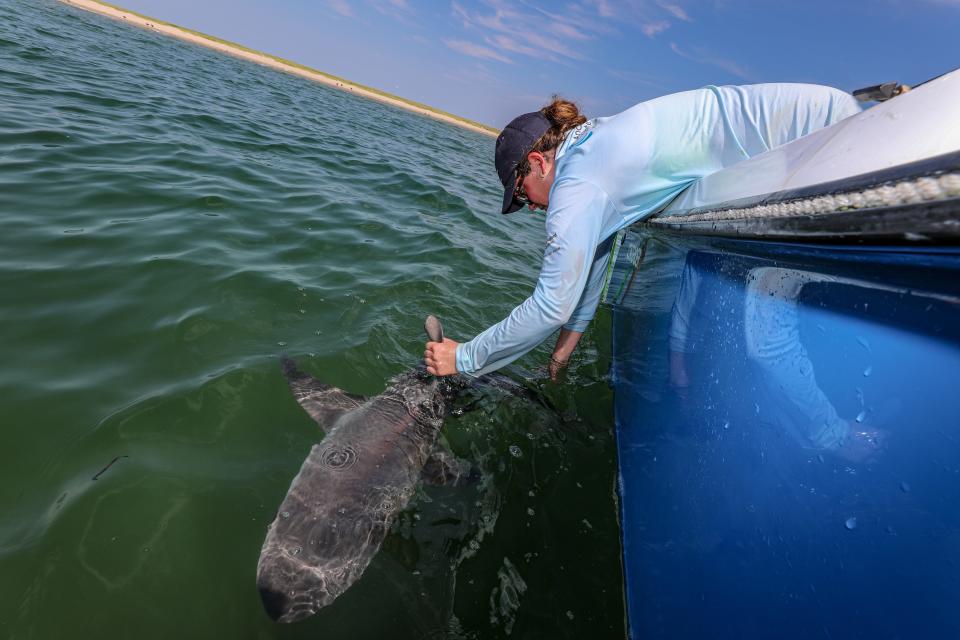Climate change is bringing new sharks to New England waters. Here's what the experts say.
Last summer, when a scalloped hammerhead shark came up within feet of one of Nantucket's south-facing beaches, it created quite the sensation.
Just feet from the beach, the shark was videoed as it hunted a bluefish, a favored meal, in "the dip" of deeper water just beyond the surf break, wowing both those who were present and the many who later viewed the video on social media.
"It was impressive," said Caroline Collatos, a UMass Boston Ph.D. student and research assistant at the New England Aquarium's Anderson Cabot Center for Ocean Life who's been studying sharks, with a focus on sandbar sharks, off Nantucket for the last three years. "Your average vacationer is not expecting a 10-foot shark to just be rolling around next to shore."
Especially one that's typically associated with more southern waters.

At least 17 species of shark swim in New England waters
While it hasn't been unheard of for some southern hammerheads to ride warm ocean currents into deeper offshore waters, it is notable that scalloped hammerheads are starting to show up close to shore, at least off Nantucket. Last year's sighting was just the latest visit in recent summers.
Great white sharks, it turns out, aren't the only big fish in the local sea, though they are getting the most attention because of the increase in numbers here — especially off Cape Cod. Plus, they are one of the biggest stars of Discovery's Shark Week, further burnishing their popularity.
There are many other sharks found in regional waters, both near shore and further out. Some, like the white sharks, are rebounding from past exploitation by human hunters, and some, like the scalloped hammerhead, are the vanguard of newcomers from the south.
Ryan Knotek, an associate research scientist with the New England Aquarium, said there are at least 17 species that call New England waters home or that pass through.
"It's a lot more than people think," he said. "They think white sharks, maybe a couple of other ones."
Some of the species commonly found here, besides the white sharks, are shortfin makos, thresher, blue, basking, tiger, sand tiger, sand bar, smooth hammerhead and whale sharks. There are also porbeagle sharks, which can tolerate cooler water and are the only so-called "resident" sharks that are present year-round.
The list is growing.

Researchers say sharks are coming north thanks to warming waters
New England, Knotek said, "is a hot spot for climate change" because the Gulf of Maine is one of the fastest-warming ocean areas in the world. As a result, fishermen, researchers and naturalists with eco-tourism boats are more frequently coming across sharks that are usually found further south.
"We're certainly seeing shifts in shark populations as a result of climate change," he said
Spinner sharks are one of the warm water species starting to show up in southern New England waters, which Knotek defines as waters from the Nantucket Sound side of Cape Cod and south.
"That's recent, in the last few years," he said of the spinners, which are typically found from the Delmarva Peninsula in the Delaware, Maryland and Virginia area south to Florida. Recently, Knotek said he received drone footage of spinner sharks preying on a giant school of Atlantic menhaden, known locally as bunker fish, near Block Island.
He wouldn't be surprised to see the sharks moving further north. But not to worry. They are not considered a threat to humans.
Collatos said black tips, another southern shark, are drifting north. Usually found in waters off Virginia and southward, they tend to migrate through shallow waters. They are not known for unprovoked aggression toward humans, but in murky water, they may mistake a swimmer's extremities for a fish and try to take a bite, according to americanoceans.org.
Sand tiger sightings are likely a good sign for the health of Massachusetts harbors
Sand tiger sharks are another species grabbing attention here, Knotek said. Generally non-aggressive, they like to hang out in shallow water. They give birth off the Carolinas, "then they make a massive migration to New England waters and use them as nurseries."
"After about two decades of protection, they're starting to show recovery," he said, noting that the species was at one time heavily overfished, "and we are now seeing them here and further north."
Duxbury Bay, he said, has been identified as a critical habitat for this species. They've also been observed in Quincy Bay and Boston Harbor, which Knotek said "speaks to the recovery" of the harbor. More research is planned to determine the extent to which the sharks are using Boston Harbor as a nursery.
Researching how sharks are affected by fishing, climate change and offshore wind
With more types of sharks showing up, there are more interactions with people, mostly sports and commercial fishermen. The state and federal governments regulate the types of sharks that can be actively fished and those that must be released.
Knotek, who works closely with commercial fishermen, researches how sharks react after being caught and released, with an eye toward understanding survival rates and identifying what fishing practices can be employed to minimize shark injuries and stress.
"Our overlying goal is to fill in critical gaps in knowledge about sharks, skates and rays — understanding how these populations are affected by human activities. My focus is on fishing industries, as well as offshore wind (projects), and also how sharks are affected by climate change, how their moving patterns might be shifting."
Some of the most frequently caught sharks here are sandbar sharks, Collatos' specialty. This is another species that's being seen more and more as the population rebounds from past exploitation. In the '80s and '90s, their numbers plummeted by 80%. They've been protected since 2008.

These sharks are found near shore — most of them actively avoid humans
Collatos spends time on shore and on the water catching, tagging and releasing sandbar sharks, though she sometimes catches other species. Her goal is to gather data, using acoustic telemetry, about the annual presence, habitat use and migration patterns of the population. It’s a long-term study to better understand the behavior and trends among the sharks, which have not been associated with human attacks.
Usually, sandbar sharks "come into our waters mid- to late June and they stay until about mid- to late September," she said. But last year one of her sharks stayed until Oct. 1 — another sign of coming changes.
Knotek said most of the shark species in this region "are further offshore and not within range of swimmers and snorkelers." Three of the most notable sharks found near shore, apart from white sharks, are basking sharks, sandbar sharks and sand tiger sharks.
Basking sharks, he said, are commonly misidentified as white sharks near the beach because they are often seen swimming near the surface with their large dorsal fin exposed. They are the second largest fish in the world and are filter feeders with barely noticeable teeth. They do not pose a threat to people.
State fisheries biologist and shark expert John Chisholm put together a video, available on the Atlantic White Shark Conservancy website, so people can learn how to tell basking sharks apart from white sharks.
As for the shallow-swimming sandbar and sand tiger sharks, Knotek said it should be noted that "juvenile and adult sandbar and sand tiger sharks are much more likely to avoid people than approach them."
Knotek, Collatos and their colleagues make it part of their mission to de-sensationalize sharks whenever they can. At the end of the day, the much-maligned sharks are not the vicious killers they are sometimes made out to be. In Knotek's book, they're just "an animal to be respected" when people go into the ocean.
"It's their world," he said.
The Cape Cod Times is investigating the effects of a rapidly heating planet on people who live on the Cape & Islands. This is part of the USA TODAY project Perilous Course. Heather McCarron writes about climate change, environment, energy, science and the natural world. Reach her at hmccarron@capecodonline.com, or follow her on Twitter @HMcCarron_CCT
Thanks to our subscribers, who help make this coverage possible. If you are not a subscriber, please consider supporting quality local journalism with a Cape Cod Times subscription. Here are our subscription plans.
This article originally appeared on Cape Cod Times: Cape Cod, New England see more shark species as waters warm

